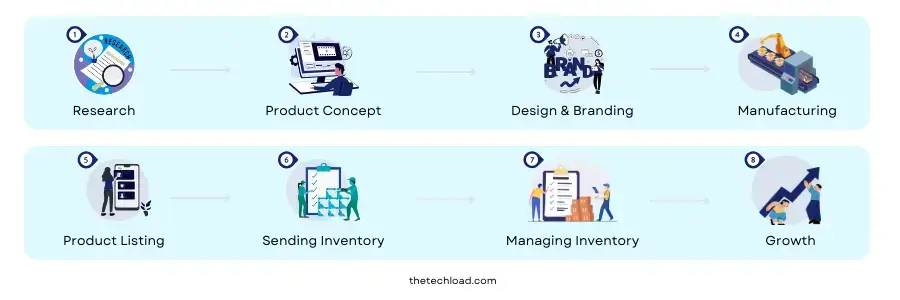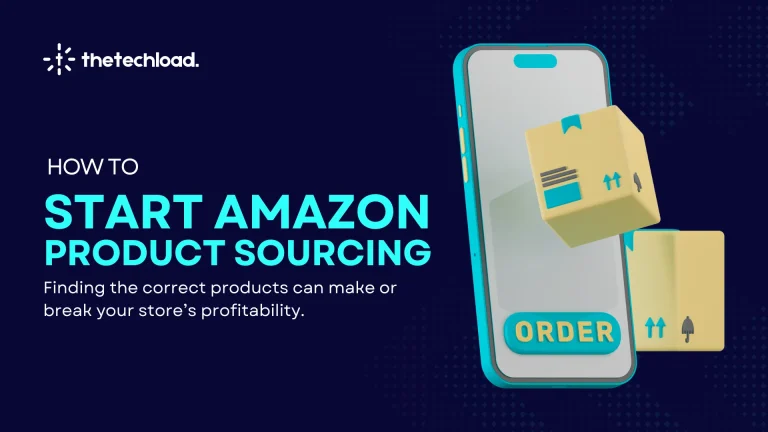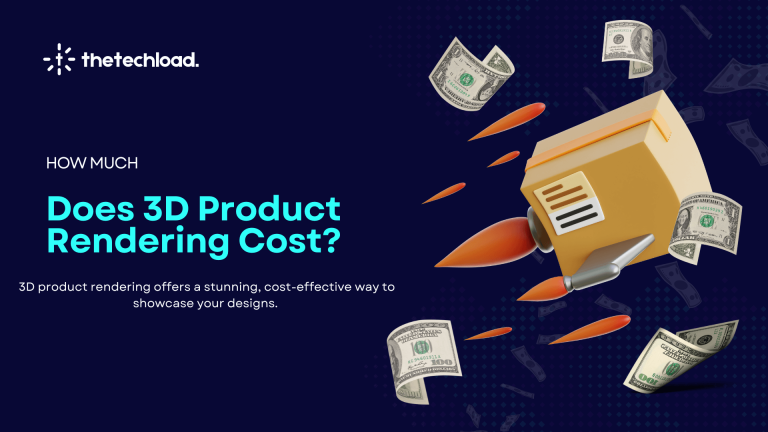Amazon product sourcing is the foundation of a successful Amazon business. Finding the correct products can make or break your store’s profitability. With the e-commerce landscape becoming more competitive in 2025, understanding the right strategies is more critical than ever.

First, sellers must research market trends, identify reliable suppliers, and select high-demand, low-competition products. Whether you’re a beginner or an experienced seller, mastering this process ensures you stay ahead in a crowded marketplace.
This guide walks you through everything you need about Amazon product sourcing in 2025. From beginner-friendly tips to advanced strategies, it’s packed with insights to help you scale your business. Keep reading to transform your sourcing approach!
What is Amazon Product Sourcing?
Amazon product sourcing refers to finding high-quality products from reliable suppliers at a low cost to sell on Amazon at a profitable price. It involves identifying trusted sources, such as manufacturers, wholesalers, or other suppliers, to ensure the products meet quality standards and customer expectations.
Why is Amazon Product Sourcing Important?
Amazon product sourcing is more than picking products to sell; it’s about making strategic choices that shape the success and sustainability of your business. Effective sourcing impacts profitability, customer satisfaction, and long-term growth in a highly competitive marketplace like Amazon. By partnering with reliable suppliers and selecting the right products, you can set the foundation for a thriving eCommerce venture.
Here’s why sourcing is vital for your success:
- Boosts Profitability: Securing products at competitive prices while maintaining high quality helps preserve healthy profit margins, even after accounting for Amazon fees, shipping costs, and marketing expenses.
- Meets Market Demand: Smart sourcing lets you identify trending or in-demand products, ensuring you stay ahead of shifting customer preferences and market trends.
- Protects Your Brand Reputation: Selling high-quality products from trustworthy suppliers strengthens your brand’s credibility and reduces risks like negative reviews or frequent returns.
- Enhances Cost Efficiency: By negotiating deals with reliable suppliers, you can lower procurement costs, offering competitive prices without sacrificing quality.
- Supports Scalability: Dependable suppliers make it easier to grow your business. Whether increasing inventory or expanding into new product categories, sourcing effectively ensures a smoother scale-up process.
The Different Types Of Amazon Product Sourcing Method
Success as a seller on Amazon is not just about picking random products; it’s about choosing the proper sourcing method. Each method has advantages and risks, catering to different budgets, experience levels, and business goals. Understanding these options will help you make informed decisions and maximize your profits.
Here are the most common Amazon product sourcing methods:
Online Arbitrage
Online arbitrage involves purchasing discounted products from online stores and reselling them at a higher price on Amazon. It’s a beginner-friendly option that doesn’t require much upfront investment.

Advantages:
- Convenience: Work from home without handling inventory physically.
- Low Risk: Requires minimal initial capital, making it perfect for beginners.
- Scalable: Easily expand your product range by sourcing from multiple online stores.
Retail Arbitrage
Retail arbitrage is buying products at low prices from physical retail stores and reselling them on Amazon at a markup. This method demands effort and research to find deals worth reselling.

Advantages:
- Accessible: No need for prior experience or large budgets.
- High-Profit Margins: Spotting heavily discounted items can yield significant returns.
- Hands-On: Great for sellers who prefer directly inspecting products before purchasing.
- Quick Returns: Enables faster cash flow than other models as products are readily available.
Dropshipping
In dropshipping, you act as a middleman. You list products on Amazon, and when a customer places an order, the supplier ships the item directly to the buyer. Sellers don’t hold any inventory themselves.

Advantages:
- Low Investment: No need to buy stock upfront or rent storage space.
- Time-Saving: Avoid packing, shipping, or managing inventory.
- Flexibility: Operate your business from anywhere with an internet connection.
Wholesale
Wholesale sourcing involves buying branded products in bulk directly from manufacturers or distributors at discounted rates and then selling them individually on Amazon.

Advantages:
- Cost Efficiency: Bulk purchases lead to lower per-unit costs, increasing profit margins.
- Reliable Supply: Building relationships with manufacturers ensures consistent product availability.
- Control: Full authority over stock, pricing, and inventory management.
Private Label
Private labeling means sourcing generic products, rebranding them as your own, and selling them on Amazon. This method often involves working with manufacturers to create custom packaging and branding.

Advantages:
- Unique Branding: Stand out from competitors by offering products under your brand name.
- High-Profit Potential: Build customer loyalty with a strong brand, leading to repeat sales.
- Scalability: Once your private label gains traction, expanding your product line is more accessible.
- Market Differentiation: Differentiated products with your branding increase customer loyalty.
How to Start Amazon Product Sourcing: Step-by-Step
Here are the steps to start Amazon product sourcing:
1. Market Research: Understanding the Demand
Market research is the bedrock of Amazon product sourcing. It helps you identify what customers want, track market trends, and understand your competitors’ strengths and weaknesses. By analyzing data, you can make informed decisions about which products to sell, avoiding guesswork and reducing risks.
How to Conduct Effective Market Research
- Leverage Research Tools: Use platforms like Jungle Scout and Helium 10 to analyze search volumes, sales trends, and competition.
- Monitor Customer Reviews: Identify gaps or complaints in popular products to develop improved versions.
- Analyze Seasonal Trends: Study products with consistent demand or those that align with seasonal spikes.
2. Identifying Profitable Niches
A profitable niche focuses on a specific audience, reducing competition and enhancing brand loyalty. Instead of targeting a broad market, you can specialize in areas with high demand but need more saturation. This targeted approach allows you to optimize your resources and stand out in the marketplace.
Steps to Find a Profitable Niche
- Evaluate Demand: Use tools to track customer searches for niche products.
- Solve Specific Problems: Focus on products that address unique customer needs.
- Check Competition Levels: Avoid niches dominated by established brands or overcrowded markets.
3. Supplier Research and Selection
Choosing the right supplier is critical to your business’s success. A good supplier ensures consistent product quality, timely delivery, and competitive pricing. On the other hand, a poor supplier can lead to costly delays, low-quality goods, and dissatisfied customers.
How to Choose a Reliable Supplier
- Request Samples: Always examine product quality before placing bulk orders.
- Verify Credentials: Look for suppliers with legitimate certifications and positive reviews.
- Communicate Clearly: Establish clear terms regarding pricing, delivery timelines, and quality standards.
4. Domestic vs. International Sourcing
Regarding Amazon product sourcing, choosing domestic and international suppliers depends on factors like shipping speed, costs, and your target market.
Domestic sourcing ensures faster delivery, more accessible communication, and more straightforward compliance with local regulations. On the other hand, international sourcing often offers lower production costs and access to a wider variety of products, making it ideal for sellers looking to optimize their profit margins.
Comparison Between Domestic and International Sourcing
- Domestic Sourcing:
- Faster delivery and better communication.
- Higher costs due to labor and production expenses.
- International Sourcing:
- Cost-effective production and material options.
- Longer shipping times and potential quality control challenges.
5. Supplier Sourcing Tactics
Supplier sourcing requires a strategic approach to ensure reliability and cost efficiency. Establishing good relationships and negotiating favorable terms can significantly impact your profit margins and supply chain stability.
Essential Sourcing Tactics
- Get Multiple Quotes: Compare prices and terms from several suppliers before finalizing.
- Negotiate Smartly: Discuss discounts, payment terms, and bulk order benefits.
- Build Relationships: Long-term partnerships often yield better terms and priority treatment.
6. Dropshipping vs. Bulk Buying
Choosing the suitable business model, dropshipping, or bulk buying depends on your initial investment, risk tolerance, and operational capacity. Each model has advantages and challenges, so understanding them is crucial to making the right decision.
Advantages and Disadvantages
- Dropshipping:
- Low initial investment and no inventory management.
- Lower profit margins and limited quality control.
- Bulk Buying:
- Higher margins and inventory control.
- Requires more capital and storage space.
7. Quality Assurance and Compliance
In Amazon product sourcing, quality assurance is vital in maintaining customer satisfaction and minimizing returns or negative feedback. Compliance ensures your business adheres to regulations, safeguarding it from legal issues.
Together, these practices are essential for building a trustworthy and successful Amazon business that stands out in the marketplace.
Steps to Maintain Quality and Compliance
- Inspect Samples: Verify product quality before placing large orders.
- Check Certifications: Ensure compliance with safety and industry regulations.
- Conduct Audits: Periodically review supplier operations for consistency.
8. Cost Analysis and Pricing Strategies
Understanding your costs and setting the correct prices are essential for staying competitive on Amazon. Cost analysis helps you determine profit margins, while a good pricing strategy ensures your product appeals to customers.
Critical Considerations for Cost Analysis
- Amazon Fees: Factor in referral, fulfillment, and storage fees.
- Shipping Costs: Account for transportation and packaging expenses.
- Marketing Costs: Include the budget for Amazon ads and promotions.
Effective Pricing Strategies
- Dynamic Pricing: Adjust prices regularly based on market conditions.
- Bundle Deals: Offer product bundles to increase average order value.
9. Inventory Management
Managing inventory efficiently prevents overstocking, reduces costs, and ensures products are available when customers need them. With tools and strategic planning, you can avoid common pitfalls like stockouts or long-term storage fees.
Tips for Inventory Management
- Use Inventory Tools: Platforms like InventoryLab help track stock levels and sales trends.
- Plan Seasonally: Anticipate demand during holidays or peak seasons.
- Monitor Aging Stock: Move slow-moving inventory through discounts or promotions.
10. Sustainability and Ethical Sourcing
Sustainability and ethical sourcing have become primary considerations for customers. Incorporating eco-friendly practices and ethical labor standards into your supply chain can give you a competitive edge.
How to Source Sustainably
- Partner with manufacturers using renewable energy and eco-friendly materials.
- Use biodegradable or recyclable packaging to reduce waste.
- Support suppliers who follow fair labor practices.
Best Tools for Sourcing Products to Sell on Amazon
Using the right tools for Amazon product sourcing can make your work as an Amazon seller much easier and more efficient. These tools help you understand product trends, prices, competition, and profits. They give you the information you need to make intelligent decisions based on accurate data.
Below are five highly essential tools for Amazon product sourcing that can streamline your journey:
1. Helium 10
Helium 10 is an all-in-one suite that helps Amazon sellers scale their businesses with ease. This tool offers an impressive range of features, from identifying trending products to optimizing product listings.
- Key Features: Keyword research, competitor analysis, and hijacker alerts to protect your listings.
- Why Use It: It’s ideal for new and experienced sellers aiming to enhance product visibility and drive sales growth.
2. Keepa
Keepa is a Chrome extension that offers extensive data on Amazon products, making it a favorite among seasoned sellers.
- Key Features: Price history charts, real-time pricing, and price drop alerts for informed sourcing decisions.
- Why Use It: Its ability to track product price trends over time ensures you buy at the right price. However, it may be more suitable for sellers with larger budgets due to its cost.
3. Jungle Scout
Jungle Scout is another powerful product research tool, available as a web app and Chrome extension.
- Key Features: Real-time sales data, revenue estimates, and Amazon keyword research.
- Why Use It: It simplifies finding profitable products and helps evaluate their potential market demand and competition.
4. Revseller
Revseller is a Chrome extension designed to assist in quickly making informed product decisions.
- Key Features: Price history, ROI and profit margin calculations, sales rank, and FBA versus MFN seller comparisons.
- Why Use It: This tool is excellent for analyzing potential profitability and is especially helpful for beginners due to its user-friendly interface.
5. Tactical Arbitrage
Tactical Arbitrage is a specialized tool for online arbitrage, enabling sellers to identify profitable opportunities efficiently.
- Key Features: Product review analysis, retail and Amazon price comparison, and profitable items filtering.
- Why Use It: It’s a game-changer for those focusing on online arbitrage, offering a detailed evaluation of product viability.
Important Amazon FBA Product Sourcing Metrics
When running an Amazon FBA business, understanding the key metrics that impact profitability is crucial. These metrics help sellers determine whether their product sourcing decisions will lead to sustainable profits or if adjustments are needed.
Here are the most important metrics to consider when sourcing products for your Amazon FBA business:
1.Amazon Product Sourcing Metrics: Profit Margins
Profit margins are among the most critical metrics for any Amazon FBA seller. They show how much money you make after deducting all your expenses, including the cost of goods, Amazon fees, shipping, and other operational costs.
Choosing products that provide healthy profit margins is essential to ensure your efforts and investment are worthwhile. Low-profit margin products may seem attractive initially, but they can be risky and hurt your business in the long run.
Always calculate your costs thoroughly and choose products with good profitability.
2. Amazon Product Sourcing Metrics: Competition
Competition plays a vital role in product sourcing. Highly competitive products might be tempting because of their demand, but they also come with challenges, such as lower margins and difficulty standing out. On the other hand, products with little competition may seem like easy wins but might need more demand to generate significant sales.
As a seller, it’s essential to strike a balance. Ideally, you want to focus on products with medium competition and demand, especially starting.
This way, you can build your reputation and reach the door without overwhelming competition.
3. Amazon Product Sourcing Metrics: Demand Levels
Demand levels fluctuate based on seasons, trends, and market changes. For example, products in high demand during specific times of the year, like Christmas decorations or fitness gear in January, can yield high profits. However, high demand also attracts more competition.
Tracking demand trends using tools like Jungle Scout or Helium 10 can help you anticipate which products will perform well and which may be oversaturated.
Understanding demand cycles and selecting products with consistent or growing demand can help you maintain steady sales throughout the year.
4. Amazon Product Sourcing Metrics: Costs and Expenses
Selling on Amazon FBA involves various costs, including Amazon fees (referral, fulfillment, and storage fees), product procurement costs, shipping fees, and marketing expenses. As a seller, it’s essential to factor these costs into your pricing strategy to ensure your products remain profitable over time.
For example, shipping fees can vary depending on product size, weight, and destination, so you must consider these when calculating your margins.
If costs start to outweigh profits, you may need to rethink your sourcing strategy or find more cost-effective suppliers.
5. Amazon Product Sourcing Metrics: Seasonal Sales
Many products experience seasonal demand, such as holiday-themed items, winter apparel, or summer outdoor gear. While seasonal products can generate significant profits during peak periods, they can be challenging during off-seasons.
When sourcing seasonal items, be cautious about overstocking and be prepared for a slow period when demand drops. Managing your inventory carefully is essential so you’re not left unsold stock after the season ends.
Diversifying your product range with seasonal and evergreen items can help you maintain a steady income year-round.
How The Techload Makes Amazon Product Sourcing Easier
Finding the right products to sell on Amazon can take much time and effort, whether you’re new to selling or an experienced pro. Beginners often need help finding the best sourcing methods, and even seasoned sellers may want to save time and try new strategies. That’s where The Techload steps in to help.
Techload is a service designed to make product sourcing simple and effective for Amazon FBA sellers. It provides ready-made lists of profitable products, helping sellers focus on growing their businesses instead of spending hours searching for deals. With daily, weekly, or monthly list options, Techload makes sourcing faster and more efficient.
Here’s how Techload helps:
- Checks Product Restrictions: Each product is reviewed to see if it’s gated (restricted) or ungated (open to sell).
- Shows Profits Clearly: The lists include details about potential profit margins and ROI so you know what to expect.
- Tracks Price Trends: TechLoad looks at price history for the last 30 and 90 days to ensure products have steady profit potential.
- Focuses on High-Ranking Products: The products included are top-sellers with high demand.
- Ensures Reliable Suppliers: TechLoad carefully checks suppliers manually and with software to provide quality products.
- Avoids Risky Items: The lists exclude dangerous materials (hazmat) and products that might lead to intellectual property (IP) complaints.
- Avoids Competing with Amazon: You won’t have to compete directly with Amazon, as their products are left out.
- Standard Sizes Only: The lists include standard-sized items to avoid shipping and storage issues.
- Limits Competition Among Sellers: The same product list is shared with only a few people, keeping competition low.
Conclusion
This guide simplifies Amazon Product Sourcing into actionable steps, ensuring you can start and scale your business confidently. Dive deeper into each section to refine your approach and achieve success in 2025.
Whether you’re sourcing domestically or internationally, through manufacturers or dropshipping, every decision plays a role in your growth. Take the time to research, plan, and execute, because smarter sourcing means greater profits!
How to Start Amazon Product Sourcing: FAQs
Amazon product sourcing is critical to profitability and success, as it selects the right products that meet demand and have healthy profit margins. It helps you stay competitive and manage costs effectively.
Tools like Helium 10, Jungle Scout, Keepa, Revseller, and Tactical Arbitrage help with product research, sales tracking, and competitor analysis, making sourcing more accessible and efficient.
Diversifying suppliers reduces risks like stockouts, price increases, and quality issues. It also provides better pricing and flexibility and ensures a consistent product supply for your Amazon business.





